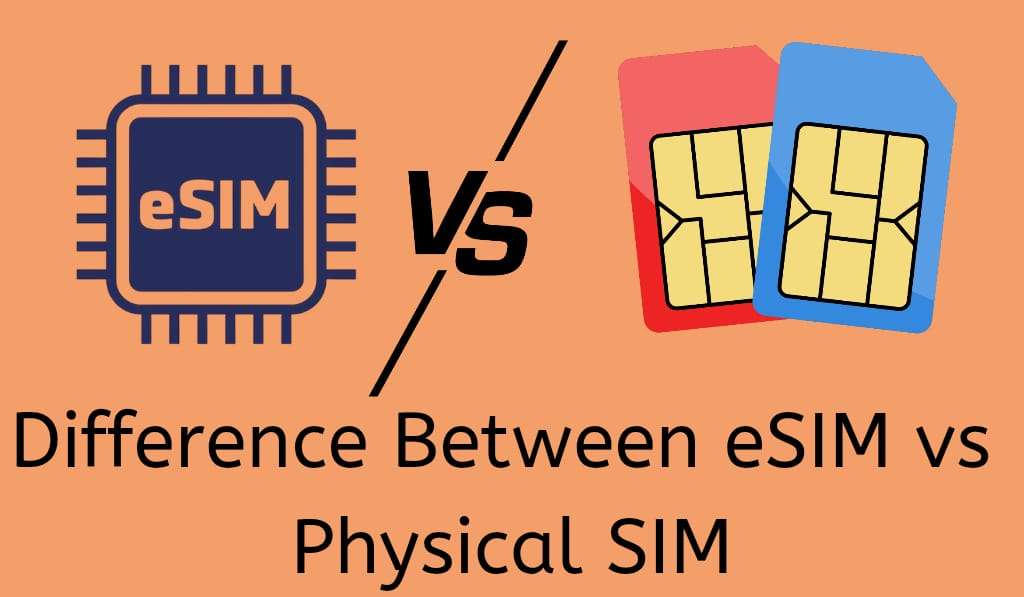In this, we will go in-depth to cover the difference between eSIM vs physical SIM. Both options have their own set of pros and cons. Whether it’s a traditional physical SIM card or a modern digital eSIM, both play a major role in your Android phone.
Difference Between eSIM vs Physical SIM
In terms of what they do, eSIMs and physical SIMs differ in terms of flexibility and convenience. Physical SIMs are in card form, which you put in your device, whereas eSIM is digital and built right into your phone. Also, eSIM supports multiple profiles and remote activation, which increases security; at the same time, physical SIMs allow easy swapping, which eSIM doesn’t, but at the trade-off, less flexibility.
Read More: How to Activate T Mobile SIM – Best 3 Methods
What is a Physical SIM?
A physical SIM is the little removable card that for decades has been used in phones. It stores your mobile number, carrier info, and enables your device to connect to the network. In the discussion of eSIM vs physical SIM, the physical SIM is put forward as more familiar because it is easy to use, replace, and move between devices.
Read More: How to Fix Cellular Network Not Available on Your Android Phone
What is an eSIM?
An eSIM, which is a digital equivalent of the traditional SIM card, is embedded into your phone at the time of manufacture. Also, unlike a physical card, which you can remove and put in another device, what you do with an eSIM is that you activate it via a QR code scan or by downloading carrier info. In the eSIM vs physical SIM debate, the main advantage of eSIM is that it is a more convenient, flexible, and green option as it does not use plastic cards.
eSIM vs Physical SIM: Main Key Differences
Here is our breakdown of eSIM and physical SIM differences:.
1. Form Factor
- Physical SIM: A removable card (of nano, micro, or standard size).
- eSIM: Integrated into the phone’s motherboard.
2. Activation
- Physical SIM: Put in the SIM card to get started.
- eSIM: Via carrier settings or QR codes.
3. Convenience
- Physical SIM: When changing carriers or numbers, you must swap out cards.
- eSIM: Gives you the ability to store many profiles and which also to easily switch between them.
4. Security
- Physical SIM: May be lost, stolen, or damaged.
- eSIM: Also more secure as it can’t be taken out.
5. Flexibility
- Physical SIM: At most one SIM per slot if dual is not an option.
- eSIM: Includes a variety of carrier options, which is great for travel and work.
Advantages of Physical SIM
Even out of the fact that eSIM is a very modern solution, many still see to it that they use physical SIM cards. Why? Well, because they are very much a part of the present landscape, they do not require you to have in-depth tech knowledge and are a simple affair to change. In the debate between eSIM vs physical SIM, a physical SIM is still the go-to in regions that do not have carrier support for eSIM.
Advantages of eSIM
On the other hand, with eSIM, we see the direction mobile connectivity is headed. In the comparison between eSIM and physical SIM, eSIM provides for smooth carrier transition, is more secure, and also supports many profiles, which the physical SIM does not. For travelers who are often on the go, eSIM is a great choice to avoid purchasing many physical SIM cards.
Which is Better: eSIM compared to a Physical SIM?
When it comes to the choice of eSIM vs physical SIM, it depends on what you need. If you go for convenience, the latest features, and also live in an area that your carrier supports with eSIM, then that is great for you. But if you still prefer the quick SIM swap, do not have eSIM-compatible devices, or just prefer the traditional option, the physical SIM is still a reliable choice.
Future of eSIM vs Physical SIM
The future of eSIM technology looks very promising. We see large Companies like Apple, Samsung, and Google in the transition to eSIM-only models. At the same time, the physical SIM is not at the end of its life yet, particularly in the developing world. The issue of eSIM vs physical SIM will play out until we see wider global adoption of eSIM.
Conclusion
One is the physical and tangible, while the other is the digital and modern. They each have what we consider to be pros and cons, and which you choose is based on your personal use, carrier support, and travel needs. Although at present physical SIM cards are still used, the move toward eSIM indicates that the future of mobile connectivity is in the digital space.
Leave a Reply